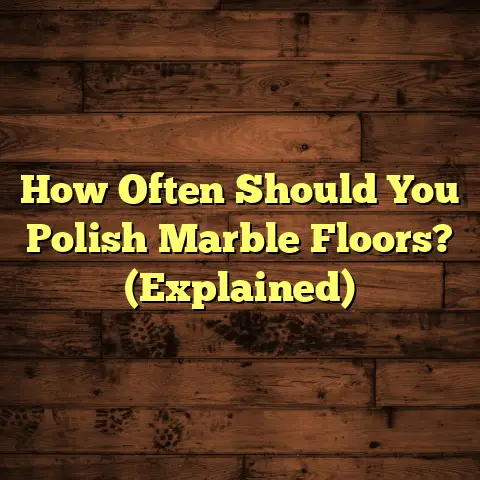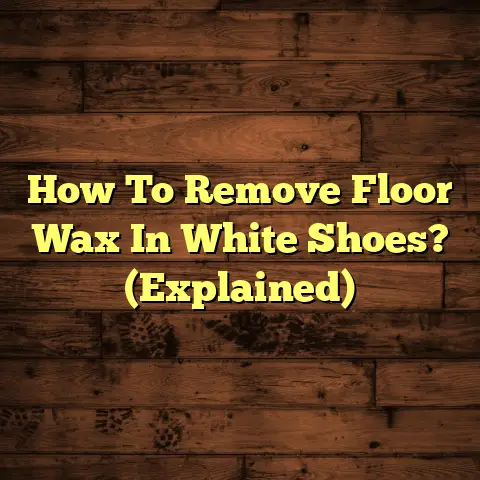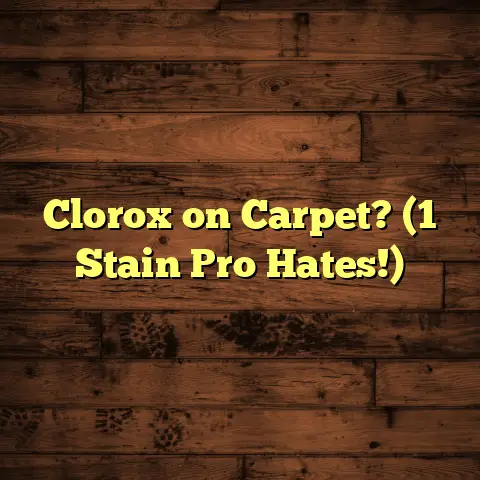How Do You Clean Hardwood Floors Before Staining?
And let me tell you, I’ve seen it all when it comes to hardwood floors – the good, the bad, and the downright ugly.
One thing I’ve learned is that the secret to a stunning, long-lasting stain job isn’t just about the stain itself.
It’s about the prep work. And that starts with a thorough cleaning.
Think of it like this: you wouldn’t paint a car without washing it first, right?
Same goes for hardwood floors.
Let’s dive into why cleaning before staining is so crucial, the tools you’ll need, and my step-by-step guide to getting it done right.
Understanding Hardwood Floors: The Foundation of Your Project
First, let’s talk about what we mean by “hardwood floors.” We’re talking about floors made from solid wood,
or engineered wood with a real wood veneer on top.
Think oak, maple, hickory, walnut – the classics!
Now, the finish on these floors is key.
It’s the protective layer that sits on top of the wood,
and it determines how you clean it.
Here are the most common types:
-
Oil-Based Polyurethane: Durable, water-resistant, and often has a slightly amber hue.
-
Water-Based Polyurethane: Clearer than oil-based, dries faster, and is lower in VOCs (volatile organic compounds).
Penetrating Oil Finishes: These finishes soak into the wood, providing a natural look and feel.
They require regular maintenance.- I find that they’re becoming more popular with homeowners who want a more natural, matte finish.
-
Pre-finished Floors: These floors are finished at the factory, often with multiple coats of a durable finish.
So, why is cleaning so important before you stain?
Well, imagine trying to stain a floor covered in dust, dirt, and old wax.
The stain won’t penetrate evenly, you’ll end up with a blotchy, uneven finish, and the stain won’t adhere properly.
Plus, any existing residue can react with the stain, leading to discoloration or other problems down the road.
Trust me, I’ve seen it happen. It’s not pretty!
Cleaning removes all those contaminants, allowing the stain to penetrate deeply and evenly, resulting in a beautiful, durable finish.
Tools and Materials: Gearing Up for Success
Okay, let’s gather our arsenal. Here’s what you’ll need to clean those floors:
-
Broom or Vacuum Cleaner: A good quality broom or vacuum with a hardwood floor attachment is essential for removing loose debris.
- I personally prefer a vacuum with a soft brush attachment, as it’s gentler on the finish.
-
Microfiber Mop: Microfiber mops are great for hardwood floors because they’re soft, absorbent, and won’t scratch the finish.
- Avoid using sponge mops, as they can leave streaks and excess water on the floor.
Cleaning Solution: This is where it gets a little tricky.
You need to choose a cleaning solution that’s specifically designed for hardwood floors and compatible with your floor’s finish.- For polyurethane finishes: I recommend a pH-neutral cleaner or a solution of mild dish soap and water.
- For penetrating oil finishes: Use a cleaner specifically designed for oiled floors.
- Avoid: Ammonia, bleach, vinegar, and abrasive cleaners, as they can damage the finish.
-
Buckets: You’ll need at least two buckets – one for your cleaning solution and one for rinsing your mop (if necessary).
Soft Cloths or Rags: These are great for spot cleaning and wiping up spills.
I always have a stack of microfiber cloths on hand.-
Scrubbing Brush (Optional): For stubborn stains or heavily soiled areas, a soft-bristled scrubbing brush can be helpful.
- Just be sure to use it gently to avoid scratching the finish.
Protective Gear: Gloves and knee pads are your friends!
Cleaning floors can be tough on your hands and knees, so protect yourself.
Preparing the Area: Setting the Stage for a Clean Sweep
Before you start cleaning, take a few minutes to prep the area.
This will make the process much easier and more efficient.
Remove Furniture and Obstacles: Clear the room as much as possible.
Move furniture to another room or cover it with drop cloths.
Remove rugs, mats, and any other obstacles.Dust/Vacuum Above Surfaces: Dust or vacuum shelves, baseboards, and other surfaces above the floor.
This will prevent dust and debris from falling onto your freshly cleaned floor.Ensure Proper Ventilation: Open windows and doors to provide good ventilation.
This will help the floor dry faster and prevent the buildup of fumes from the cleaning solution.- If the weather isn’t cooperating, use fans to circulate the air.
Cleaning Process: The Nitty-Gritty
Alright, let’s get down to business!
Here’s my step-by-step guide to cleaning
hardwood floors before staining:
Step 1: Initial Sweep/Vacuum
- Start by sweeping or vacuuming the entire floor to remove loose dirt, dust,
and debris.
Pay special attention to corners, edges, and areas under furniture.- Pro Tip: Overlap your strokes to ensure you’re picking up everything.
Step 2: Choosing the Right Cleaning Solution
- As I mentioned earlier, selecting the right cleaning solution is crucial.
Read the label carefully and make sure it’s specifically designed for hardwood floors and compatible with your floor’s finish.- When in doubt, test the cleaner in an inconspicuous area first to make sure it doesn’t damage the finish.
Step 3: Mopping the Floors
- Now it’s time to mop!
Here’s the key: damp, not wet.
You don’t want to saturate the floor with water.- Dip your microfiber mop into the cleaning solution and wring it out thoroughly.
- Mop the floor in the direction of the wood grain, using a back-and-forth motion.
- Overlap your strokes slightly to ensure you’re covering the entire surface.
- Rinse your mop frequently in the clean water bucket to remove dirt and grime.
- Change the cleaning solution when it becomes dirty.
- Pro Tip: If you’re using a spray mop, spray the cleaner directly onto the mop head, not the floor.
Step 4: Spot Cleaning Stains
- If you encounter any stubborn stains, try spot cleaning them with a soft
cloth and appropriate cleaner.
- For water stains: Try gently rubbing the area with a soft cloth dampened with mineral spirits.
- For grease stains: Apply a paste of baking soda and water to the stain, let it sit for a few minutes, and then wipe it away with a damp cloth.
- For scuff marks: Use a pencil eraser to gently rub away the marks.
- Pro Tip: Always test your cleaning solution in an inconspicuous area first to make sure it doesn’t damage the finish.
Step 5: Rinsing (If Necessary)
- Depending on the cleaning solution you used, you may need to rinse the
floor with clean water.
- If the cleaning solution leaves a residue, or if you’re using a concentrated cleaner, rinsing is a good idea.
- To rinse, simply mop the floor with a clean, damp microfiber mop and clean water.
- Be sure to wring out the mop thoroughly to avoid over-wetting the floor.
Drying the Floor: Patience is a Virtue
Once you’ve cleaned the floor, it’s crucial to let it dry completely
before applying stain.
This can take anywhere from a few hours to overnight,
depending on the humidity and ventilation.
-
Open Windows and Doors: As I mentioned earlier, good ventilation will help the floor dry faster.
-
Use Fans: Position fans around the room to circulate the air.
Avoid Walking on the Floor: Keep pets and foot traffic off the floor until it’s completely dry.
- Pro Tip: Place a piece of plastic wrap on the floor and tape
down all the edges.
Leave it in place for 24 hours and then peel it back to see if any moisture has collected underneath.
If it has, the floor isn’t dry enough to stain.
- Pro Tip: Place a piece of plastic wrap on the floor and tape
down all the edges.
Final Inspection: The Last Line of Defense
Before you move on to staining, take a close look at the floor to make sure you haven’t missed any spots or left behind any residue.
Check for Streaks: Look for any streaks or watermarks on the floor.
If you see any, buff them out with a clean, dry microfiber cloth.-
Inspect Corners and Edges: Pay special attention to corners and edges, as these areas are often overlooked.
Feel for Residue: Run your hand over the floor to feel for any sticky or slippery residue.
If you feel any, re-clean the area with a clean, damp microfiber mop.Pro Tip: Use a flashlight to shine a light across the floor.
This will help you spot any imperfections that you might otherwise miss.
If you find any areas that need additional cleaning, don’t hesitate to
go back and touch them up.
It’s better to take the time to do it right
now than to have problems with the stain later on.
Transitioning to Staining: The Final Countdown
Okay, your floors are clean, dry, and ready for stain!
Before you start staining, there are a few more things to consider:
Ensure the Environment is Dust-Free: Dust can ruin a stain job, so take steps to minimize dust in the area.
Close windows and doors, cover furniture with drop cloths, and avoid sweeping or vacuuming while you’re staining.Sand Lightly: Depending on the condition of your floors, you may need to lightly sand them before staining.
This will help open up the wood pores and allow the stain to penetrate more evenly.- I usually recommend using a fine-grit sandpaper (220-grit or higher) and sanding in the direction of the wood grain.
Tack Cloth: After sanding, use a tack cloth to remove any remaining dust.
A tack cloth is a sticky cloth that’s designed to pick up dust without leaving any residue behind.-
Test the Stain: Before you start staining the entire floor, test the stain in an inconspicuous area to make sure you like the color and that it’s penetrating properly.
Conclusion: The Path to a Perfect Finish
So, there you have it!
My comprehensive guide to cleaning hardwood floors
before staining.
Remember, thorough cleaning is the foundation of a beautiful,
long-lasting stain job.
By following these steps, you’ll ensure that your stain penetrates deeply and evenly, resulting in a finish that you’ll be proud of for years to come.
Don’t skip this crucial step!
Happy staining, and may your floors be ever beautiful!





